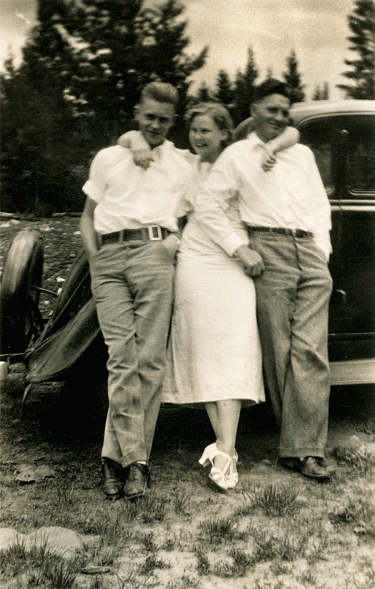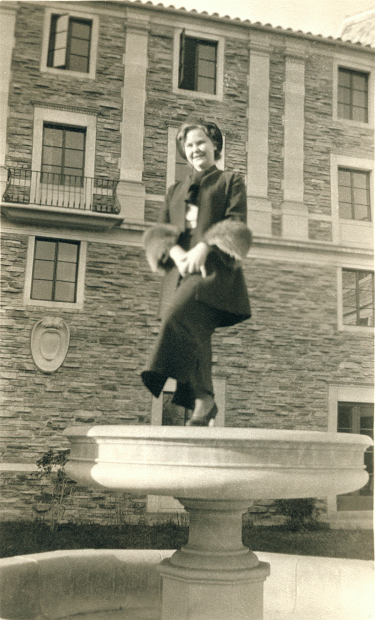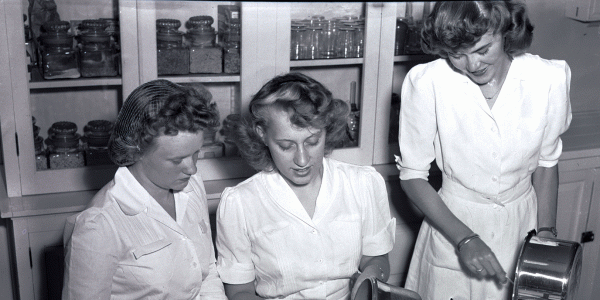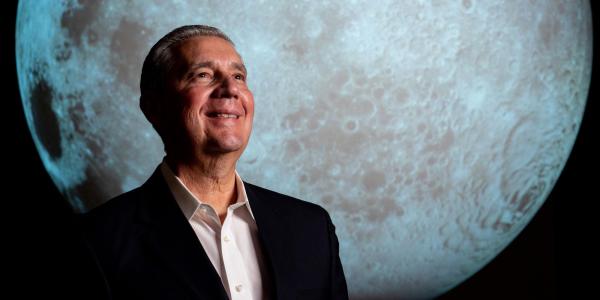 Eleanor Carlson Flanders in Old Main, the former home of the CU journalism school.
Eleanor Carlson Flanders in Old Main, the former home of the CU journalism school.
A tiny but growing number of Americans live to age 100 or beyond. A pair of CU centenarians (and two on the cusp) recall the 1930s.
With one little suitcase packed with homemade clothes, Eleanor Carlson Flanders (Jour’38) arrived at her fourth floor room in the female-only residence hall then known simply as “The Dorm.” It was August 1934 and the Yuma, Colo., resident was amazed by what she saw.
“My dorm room was the best room I ever had,” Flanders said in an April interview, recalling the scenic view of campus from what is now called Sewall Hall. “I thought the Flatirons were going to fall on me.”
With even greater awe, she glimpsed a shower for the first time.
“I wrote my brother and said, ‘Dear little Billy, we have a bath here that comes down like rain!’” said Flanders, the oldest of seven siblings who grew up on a farm severely affected by the Dust Bowl drought that devastated the Great Plains.
Today there are nearly 300,000 living CU Boulder alumni. Flanders is among the robust few who can tell firsthand tales of Depression-era campus life, and she’s among the tiny contingent of alumni — estimated at about 60 individuals — who have reached age 100.
 Flanders in 1916, her first year.
Flanders in 1916, her first year.
 At CU she studied journalism and liked dancing.
At CU she studied journalism and liked dancing.
 Outside Sewall Hall during a visit as an alumna.
Outside Sewall Hall during a visit as an alumna.
When Flanders hit the century mark on March 27, 2016, Easter Sunday, she became one of about 72,000 American centenarians, a group that accounts for just 0.02 percent of the population, according to 2014 Census data. Though centenarians are still rare, their ranks are expanding and they’re part of the fastest growing segment of the U.S. population — people 65 and older, according to Winifred Rossi of the National Institute on Aging (NIA).
Even at 100 and beyond, life can be good overall, according to Rossi, deputy director in NIA’s division of geriatrics and clinical gerontology. NIA-funded research has found that some centenarians experienced delayed onset of aging-related diseases, such as heart disease or arthritis, she said. Others experienced no aging-related diseases at all.
“Further,” Rossi said, “many centenarians tend to maintain their ability to function independently, largely escaping disability.”
Flanders, who lives in a retirement community in Broomfield, Colo., didn’t think much about turning 100 until about a month after her birthday.
“Yesterday, I decided I felt like I was 100,” she said. “I was tired, and bridge went poorly.”
Eight decades have passed since Flanders and her fellow CU centenarians attended the university.
Her first day on campus was an exciting start to a new life — one that has generated a century’s worth of memories. In her junior year she met Laurence Flanders (Fin’38; Law’40), her future husband. Together, they lived through World War II, raised four children, worked and played golf and competitive bridge.
Flanders’ favorite recreation at CU was attending tea dances for non-Greek members held in the Memorial Student Union (predecessor of the University Memorial Center and now the economics building) along Broadway for 10 cents every Monday evening. Required coursework was broad, but practical.
“Everyone had to take two years of gym, pass a spelling test and pass a swimming test to graduate from CU with any degree,” said Flanders, who majored in journalism because she was enamored by the adventures of Brenda Starr, a comic strip character who was a reporter.
Helen Duhon (Jour’38), also 100, was Flanders’ classmate in the journalism school, then housed in the basement of Old Main. She was in the Tri-Delta sorority and wrote news for the student newspaper of the day, The Silver and Gold, and a person-on-the-street column called “What Do You Think?”
After a full career — including 21 years as assistant editor at the Colorado Alumnus, now Coloradan magazine — Duhon, originally from Nebraska, leads a quiet life in Boulder. She enjoys company and having people read to her, especially from newspapers.
“Life seemed pretty busy and it moves along really fast as you get older,” she said. “You don’t think about being 100 at all.”
There are far more women centenarians than men, consistent with mortality trends by sex. According to Census data from 2014, there were 58,468 women and 13,729 men centenarians in the U.S., or 4.2 woman centenarians for every man.
On the cusp of turning a century old is Basil Indermill (Pharm’40). He turns 100 next May.
Age has only increased his love for life.
“I feel alive,” he said with enthusiasm in a phone interview from his home in Oceanside, Calif. “I wake every morning anxious to see what is going to happen during the day.”
Indermill, one of eight siblings, moved to Boulder from his family’s ranch in Two Buttes, Colo., near the Kansas and Oklahoma state borders, in 1936, and recalls living off 85 cents a week his first year at CU.
He enrolled in the pharmacy college (now part of CU Denver) intending to follow in his older brother’s footsteps. But along the way, through some elective courses, he discovered an interest in woodworking and machinery. It grew into a livelihood, and Indermill operated a machine shop in Bakersfield, Calif., for 30 years.
Today, he lives with his daughter Kathy, 66, and enjoys walking, croquet, exploring the internet and writing.
“I wouldn’t trade me for anybody,” he said.
Eleanor Flanders' 10 Secrets to Living to 100:
1. Happiness: It’s up to you.
2. Curiosity: Always go.
3. Open doors: Walk on through.
4. Mistakes: Your best primer for learning.
5. Tomorrow: Optimism and dreams give you hope.
6. Friends: It takes a village. Stay involved.
7. Gratitude: Your guardian angel works 24/7.
8. Generosity: Cast your bread on the waters.
9. True you: Be a unique piece of the puzzle.
10. Smile: It’s your first gift to others.
For all the variety in their lives, today’s centenarians (and those soon to be) all share memories of World War II.
Martin Trotsky (Acct’42), 98, arrived at CU in the depths of the Great Depression. In 1938, he was a 20-year-old freshman from New Haven, Conn., and was living off $15 a month — enough to dine on skim milk and spaghetti, as he put it.
A star athlete in baseball and basketball who took business classes in the Woodbury building, Trotsky was part of the 1940 basketball team that won the National Invitational Tournament. He joined a fraternity and met his future wife, Gloria (Mus’43), at a fall dance.
In his senior year, World War II completely changed Trotsky’s life. He recalls listening to the radio in December and learning that Pearl Harbor had been bombed. He called out to the six other men in the Phi Sigma Delta fraternity house dining room: “You better get your draft cards ready. We’re at war.”
Trotsky joined the Marine Corps and spent four years after graduation as an air combat intelligence officer and captain in the Gilbert, Marshall and Mariana Islands in the Pacific.
As he approaches 100, Trotsky recalls the time solemnly, reflecting on people he knew who were killed in battle.
“I was very lucky,” he said from the Denver condominium where he and Gloria, 95, live.
Flanders views the war as a test of her resilience and strength. While her husband spent three years in both the Atlantic and the Pacific on the battleship Nevada after it narrowly escaped the Japanese attack on Pearl Harbor, she spent much time alone, taking care of their first child and their home in Longmont. The couple’s third anniversary was on D-Day; he was anchored just 1,000 yards offshore of Utah Beach.
“I faced the possibility that he might never return,” she said, adding that he managed to send her flowers.
Flanders said the independence she learned at CU Boulder helped her get through the war and helps her enjoy old age. She uses a computer daily to email friends, look up her score in bridge and even to manage her money on a spreadsheet. She lives alone, contentedly, and after a century of living still looks forward to what’s next.
Photos courtesy Eleanor Carlson Flanders





